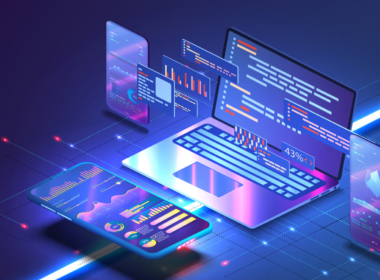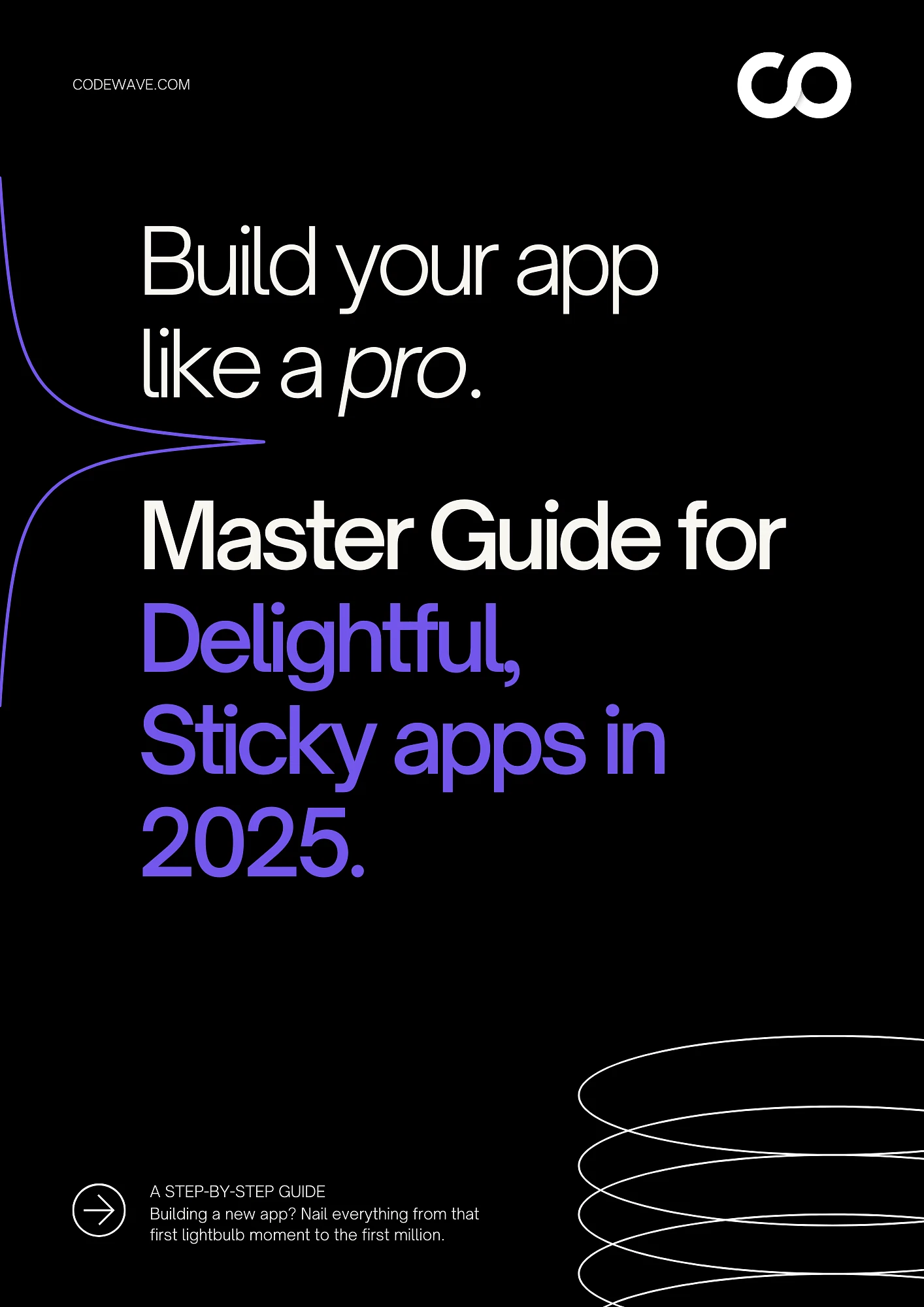ML and AI-based app development has great potential for your business. According to recent data, the global machine learning market is seeing strong growth. It’s valued at about $55.8 billion in 2024 and is expected to climb to nearly $282.13 billion by 2030, with an annual growth rate of around 30.4% starting in 2025.
In fact, the AI app development market is also set to expand, growing from about $40.3 billion in 2024 to around $221.9 billion by 2034, at a steady 18.6% yearly growth rate. But building ML apps requires the right strategy, tech stack, and execution approach.
In this guide, we cover everything you need to build machine learning apps that solve real problems, from planning and data preparation to deployment and scaling. Let’s get into it.
Key Takeaways:
- For successful machine learning development, it’s essential to start with specific business problems and user needs before choosing ML technology.
- Quality data is more important than complex algorithms for successful ML apps.
- Simple models that work consistently are better than sophisticated ones that fail in production.
- ML apps require different testing methods than traditional software applications.
- Machine learning app development success metrics include revenue and engagement, not just technical accuracy.
What Is Machine Learning App Development?
Machine learning app development combines traditional software engineering with AI capabilities to create applications that learn and improve from data. Unlike regular apps that follow predetermined rules, ML apps adapt their behavior based on patterns they discover in user data.
For example, a retail app might use ML to recommend products based on browsing history, while a healthcare app could predict patient risk factors from medical data. The key difference is that these apps get smarter over time as they process more information.
The process involves training mathematical models on relevant data, then integrating these models into user-facing applications. This requires expertise in both data science and software development, which is why many companies partner with specialists rather than building everything in-house.
Machine learning apps work by adapting to user patterns rather than following fixed rules. This flexibility creates opportunities that traditional software simply can’t match.
Why Invest in Machine Learning App Development?
ML-powered apps create significant competitive advantages. Here’s how ML apps create measurable business impact for companies across industries.
- Revenue Growth: Personalized recommendations can increase sales by matching customers with products they actually want.
- Cost Reduction: Automated processes reduce manual work and human error, saving operational expenses and freeing teams for higher-value tasks.
- User Engagement: Smart features keep users active longer than static apps because they provide relevant, personalized experiences.
- Market Differentiation: AI capabilities become selling points that set you apart from competitors still using basic rule-based systems.
- Scalable Intelligence: ML handles complexity that would overwhelm human teams, processing millions of data points to make instant decisions.
- Future-Proofing: Apps that learn stay relevant as markets change, adapting to new patterns automatically.
Struggling to compete with larger companies that have dedicated AI teams? Our AI/ML Development services help businesses of all sizes build intelligent features that deliver measurable results from day one.
The business benefits are clear, but many companies get stuck on execution. Here’s the proven process that turns ML concepts into working applications.
How Does Machine Learning App Development Work?
Building ML apps follows a structured process that combines data science with software engineering. Each stage builds on the previous one, creating a foundation for intelligent features that work reliably in production.
Here’s the complete development workflow that turns your business requirements into working ML applications.
- Problem Definition and Goal Setting: Define specific business problems your app will solve, identify target users, and establish success metrics that align with business objectives.
- Data Collection and Preparation: Audit existing data sources, identify gaps, clean and structure data for model training, and set up automated pipelines for ongoing data collection.
- Model Selection and Training: Choose appropriate algorithms based on your problem type and data characteristics, train multiple model variants, and optimize performance for your specific use case.
- Model Evaluation and Optimization: Test model performance across different user segments, validate against business metrics, and refine algorithms for accuracy and efficiency.
- Integration Architecture: Build the software infrastructure to serve ML predictions in real-time, design APIs for model communication, and plan for model updates without service interruption.
- UI/UX Design: Create interfaces that present AI insights clearly to users, design feedback mechanisms for continuous learning, and ensure ML features enhance rather than complicate the user experience.
- Testing and Quality Assurance: Validate model performance across edge cases, test infrastructure under realistic load conditions, and verify data privacy and security measures.
- Monitoring and Iteration: Track both technical performance and business metrics, set up alerts for model degradation, and establish processes for regular model updates.
For instance, building a customer service chatbot starts with collecting conversation data, training natural language models, integrating them with your app’s messaging system, designing chat interfaces, and continuously improving responses based on user interactions.
Following a structured development process keeps projects on track and reduces costly mistakes. Your next decision involves choosing which type of ML app fits your business needs.
What Are the Types of Machine Learning Apps You Can Build?
ML applications span multiple categories, each serving different business needs and user experiences. Knowing these types helps you choose the right approach for your specific goals.
| App Type | Use Cases | Complexity Level | Timeline | ROI Potential |
| Recommendation Systems | E-commerce, content, products | Medium | 3-6 months | High |
| Predictive Analytics | Finance, healthcare, logistics | High | 4-8 months | Very High |
| Computer Vision | Quality control, security, retail | High | 4-10 months | High |
| Natural Language Processing | Customer service, content analysis | Medium-High | 3-7 months | Medium-High |
| Personalization Engines | Marketing, user experience | Medium | 2-5 months | High |
Here are the most popular ML app categories and how they create value for different industries.
Recommendation and Personalization Apps
These apps analyze user behavior to suggest relevant content, products, or actions. Spotify uses ML to create personalized playlists, while LinkedIn recommends connections and job opportunities. They work by finding patterns in user interactions and predicting what someone might want next. Implementation typically involves collaborative filtering algorithms that compare user preferences with similar customers to surface relevant suggestions.
Predictive Analytics Applications
These apps forecast future outcomes based on historical data. For example, inventory management systems predict demand patterns to prevent stockouts, while financial apps assess credit risk using transaction history and demographic data. They help businesses make data-driven decisions before problems occur. The key is collecting quality historical data and choosing models that balance accuracy with interpretability.
Computer Vision Applications
These apps process and analyze visual information to automate tasks that previously required human eyes. Retail apps might identify products in photos for visual search, while manufacturing apps detect quality issues on assembly lines using camera feeds. They turn visual data into actionable insights. Success depends on having diverse, high-quality image datasets and choosing the right neural network architecture.
Natural Language Processing Apps
These apps parse and respond to human language to automate communication tasks. Customer service chatbots answer questions automatically using conversation data, while content analysis tools extract insights from text data for market research. They connect human communication with software systems. The challenge is handling context, intent, and the nuances of human language accurately.
Different ML app types serve different purposes, but all successful implementations share certain essential characteristics. These main features determine whether your app works reliably in production.
What Are the Key Features Every ML App Needs?
Successful ML applications share certain core capabilities that make them reliable, scalable, and user-friendly. These features separate production-ready apps from basic prototypes.
Building ML apps that actually work in the real world requires more than just accurate models. Here are the essential components every ML application needs to succeed.
- Real-Time Inference: Process predictions quickly enough for smooth user experiences, typically under 100 milliseconds for consumer apps, with fallback caching for high-traffic periods.
- Data Pipeline Management: Collect, clean, and process data automatically using scheduled jobs, handle missing or corrupted data gracefully, and maintain data quality through validation checks.
- Model Versioning: Track and manage different versions of your ML models using tools like MLflow, enable rollbacks when new models perform poorly, and compare model performance across versions.
- Performance Monitoring: Track accuracy metrics in real-time, detect when models need retraining due to data drift, and alert teams when performance drops below acceptable thresholds.
- Fallback Mechanisms: Handle cases when ML predictions aren’t available or confident, provide rule-based alternatives for edge cases, and ensure app functionality doesn’t break during model updates.
- User Feedback Loops: Collect explicit and implicit user feedback to improve model accuracy, implement rating systems for recommendations, and use behavioral data to refine predictions.
- Security and Privacy: Protect sensitive data through encryption and access controls, comply with regulations like GDPR and CCPA, and implement data anonymization where possible.
- Scalable Infrastructure: Handle varying loads without performance degradation using cloud-based auto-scaling, optimize model serving costs through efficient resource allocation, and plan for geographic distribution.
For instance, a customer support app needs real-time sentiment analysis to route urgent issues instantly, data pipelines to process thousands of conversations daily, and fallback rules when ML models are uncertain about customer intent.
Worried about building infrastructure that can handle enterprise-scale ML workloads? Our Custom Software Development team designs ML applications with scalability built-in, so your app can grow with your business.
Building the right features from the start saves time and prevents expensive rewrites later. Budget planning requires realistic cost expectations for your specific requirements.
How Much Does Machine Learning App Development Cost?
ML app development costs vary significantly based on complexity, data requirements, and infrastructure needs. Getting accurate cost estimates helps you budget properly and make informed build-versus-buy decisions.
The investment breakdown varies by project scope, but here’s what you can typically expect across different development phases.
| Development Phase | Simple ML App | Complex ML App | Timeline | Key Activities |
| Discovery & Planning | $10,000-15,000 | $20,000-25,000 | 2-4 weeks | Requirements, data audit, and architecture |
| Data & Modeling | $25,000-50,000 | $75,000-100,000 | 4-8 weeks | Data cleaning, model training, testing |
| App Development | $50,000-100,000 | $150,000-200,000 | 8-16 weeks | Integration, UI/UX, backend systems |
| Testing & Deployment | $15,000-25,000 | $35,000-50,000 | 2-4 weeks | QA, performance testing, launch |
| First Year Maintenance | $20,000-40,000 | $60,000-80,000 | Ongoing | Monitoring, updates, support |
Several key factors determine where your project falls within these cost ranges.
- Data Complexity: Clean, structured data costs less to work with than messy datasets requiring extensive preprocessing, while missing data can add 20-40% to modeling costs.
- Model Sophistication: Simple classification models cost less than deep learning systems, and pre-trained models reduce development time compared to training from scratch.
- Platform Requirements: Web-only applications cost less than mobile plus web plus API implementations, while real-time mobile apps require more complex infrastructure.
- Integration Complexity: Connecting to existing systems and databases adds development time, especially for legacy systems without modern APIs.
- Performance Requirements: Real-time processing costs more than batch processing due to infrastructure needs, while high-availability systems require redundancy and monitoring.
- Compliance Requirements: Regulated industries like healthcare and finance require additional security measures, audit trails, and documentation.
For example, a basic recommendation engine for an e-commerce site might cost $75,000-150,000, while a computer vision app for manufacturing quality control could range from $200,000-500,000 due to complex image processing requirements.
Smart companies start with focused MVPs to validate concepts before investing in full-scale development. This approach reduces risk and proves business value early.
Cost estimates help with budget planning, but your technology choices affect long-term success and maintenance expenses. The right tech stack supports both current needs and future growth.
How to Choose the Right Technology Stack for ML Apps?
Your technology choices determine how well your ML app performs, scales, and integrates with existing systems. The right stack balances functionality, performance, and development speed.
Making informed technology decisions early prevents costly rewrites later and ensures your ML app can grow with your business needs.
Machine Learning Frameworks
Selecting the right ML framework affects everything from development speed to production performance. Here’s what each major option offers and when to use them.
- TensorFlow: Best for complex models and production deployment, offers strong mobile support through TensorFlow Lite, an extensive community, and Google backing, making it ideal for computer vision and NLP projects.
- PyTorch: Perfect for research and rapid prototyping, more intuitive debugging and development experience, increasingly popular for production through TorchServe deployment tools.
- Scikit-learn: Excellent for traditional ML algorithms like classification and regression, lightweight and easy to integrate, ideal for projects that don’t need deep learning complexity.
- MLflow: Essential for experiment tracking and model management, handles model versioning and deployment pipelines, and integrates with most ML frameworks for production workflow management.
Backend Infrastructure
Your backend choices affect scalability, maintenance, and integration capabilities. Choose based on your team’s expertise and project requirements.
- Python: Most popular for ML development and integration, extensive ML libraries and community support, handles both model training and API serving effectively.
- Node.js: Excellent for fast API development and real-time features, a good choice when you need to integrate ML with existing JavaScript applications.
- Docker: Ensures consistent deployment across development, testing, and production environments, making model serving portable and scalable.
- Kubernetes: Provides scalable container orchestration for enterprise deployments, handles auto-scaling and load balancing for ML inference services.
Database and Storage Solutions
Data storage decisions impact performance, costs, and scalability. Match your database choice to your data patterns and access requirements.
| Solution | Best For | Advantages | Use Cases |
| PostgreSQL | Structured data & analytics | ACID compliance, complex queries | User data, transactions, reports |
| MongoDB | Unstructured data storage | Schema flexibility, horizontal scaling | User-generated content, logs |
| Redis | Real-time predictions | Sub-millisecond response times | Caching, session storage |
| AWS S3/Google Cloud | Data lakes & model storage | Unlimited scale, cost-effective | Training data, model artifacts |
For instance, a real-time recommendation system might use TensorFlow for models, Python with FastAPI for serving predictions, Redis for caching user preferences, and React for the user interface.
Choosing technologies early prevents major headaches during development and deployment. Here’s how to execute your ML app project from concept to launch.
Step-by-Step Process to Build a Machine Learning App
Building ML apps requires a systematic approach that balances technical requirements with business objectives. This process ensures your app solves real problems and delivers measurable value. Here’s how can you can build ML apps step-by-step:
Phase 1: Strategy and Planning
Define your business problem with precision before writing any code. This phase determines whether your ML project succeeds or becomes an expensive experiment that never launches.
Example: If you’re building an e-commerce app, don’t just say “improve recommendations.” Instead, define it as “reduce cart abandonment among mobile users who browse multiple products but don’t purchase.”
Implementation Strategies:
- User research interviews: Conduct detailed conversations with actual customers to understand their decision-making process and identify where intelligent automation would help most.
- Specific success metrics: Set measurable goals that align with business outcomes, such as increasing average order value or reducing customer service ticket volume.
- Clear user stories: Document specific scenarios that describe how different customer types will interact with your ML features and what value they expect to receive.
- Project roadmap creation: Develop a timeline with weekly milestones, budget allocation for each phase, and clear deliverables for stakeholder review.
Phase 2: Data Strategy and Preparation
Your ML model is only as good as the data you feed it. This phase often consumes the majority of your development time, but cutting corners here will likely result in poor outcomes later.
Example: If you’re building a customer support chatbot, you need conversation logs, resolution outcomes, customer satisfaction scores, and agent performance data. Missing any of these elements limits your model’s ability to learn effective responses.
Implementation Strategies:
- Data source audit: Create a comprehensive inventory of all existing data sources, including their quality levels, update frequencies, and any missing fields that could impact model performance.
- Quality validation systems: Set up automated checks that flag data issues like duplicate records, inconsistent formats, or missing critical information.
- Data standardization processes: Create procedures that ensure consistent formatting across all sources, making data usable for machine learning algorithms.
- Ongoing collection infrastructure: Build systems that automatically capture new user interactions, feedback, and outcomes to keep your models current and accurate.
Phase 3: Model Development and Training
Choose algorithms based on your specific problem type and data characteristics, not what’s most advanced or trendy. The best model is the one that reliably solves your business problem.
Example: If you’re building a recommendation system for a clothing retailer, start with collaborative filtering to suggest items based on similar customer purchases before attempting complex approaches that require massive datasets.
Implementation Strategies:
- Baseline model establishment: Begin with simple algorithms to create performance benchmarks that more complex models must beat to justify their additional complexity.
- Business metric optimization: Focus on improving metrics that matter to your business, such as user engagement or conversion rates, rather than just technical accuracy.
- Multiple algorithm testing: Train different model types and compare their real-world performance to identify the best approach for your specific use case.
- Model validation processes: Test how well your models perform on new, unseen data to ensure they work reliably in production environments.
Phase 4: Application Development and Integration
Build the software infrastructure to serve ML predictions without breaking your existing systems. This phase transforms trained models into features that users can actually interact with.
Example: If you’re adding personalized recommendations to an existing e-commerce platform, your system needs to access real-time inventory data and user history while serving suggestions quickly enough to maintain a smooth user experience.
Implementation Strategies:
- System integration planning: Design how ML predictions will connect with your existing databases and user interfaces without disrupting current functionality.
- Performance optimization: Implement caching and efficient data retrieval to ensure ML features respond quickly during peak usage periods.
- Fallback strategy development: Create backup systems that provide reasonable alternatives when ML models are unavailable or return uncertain predictions.
- Testing infrastructure setup: Build systems that allow you to compare new ML features against existing functionality using real user traffic.
Phase 5: Testing and Quality Assurance
ML apps require different testing approaches than traditional software because their behavior depends on data patterns rather than fixed business logic.
Example: If you’re testing a customer recommendation system, you need to verify that it works for new users with no purchase history, long-time customers with diverse interests, and edge cases, such as customers who only buy seasonal products.
Implementation Strategies:
- Diverse scenario testing: Create test cases that represent different user types and behaviors to ensure your ML system works across your entire customer base.
- Load capacity validation: Test how your system performs under realistic traffic conditions to identify potential bottlenecks before launch.
- Bias and fairness evaluation: Analyze whether your ML system treats different user groups fairly and provides consistent quality of service.
- Security assessment: Verify that your ML features protect user data and resist potential attacks or manipulation attempts.
Phase 6: Deployment and Monitoring
Launch your ML app with careful observation of both technical performance and business outcomes. This phase determines whether your investment delivers the expected value.
Example: If you’re deploying a recommendation engine, start by showing ML-powered suggestions to a small percentage of users while others continue with the existing system, and then gradually increase the percentage based on performance metrics.
Implementation Strategies:
- Gradual rollout strategy: Launch ML features to limited user groups first, expanding gradually based on performance and user feedback.
- Real-time monitoring setup: Create dashboards that track both technical performance and business impact, allowing you to identify issues quickly.
- Alert system configuration: Establish automated notifications when key metrics fall outside acceptable ranges or when system errors occur.
- Rollback procedures: Prepare quick response plans that allow you to revert to previous versions if new deployments cause problems.
Phase 7: Optimization and Scaling
Continuously improve your ML app based on real user behavior and performance data. This ongoing phase ensures long-term success and return on investment.
Example: If your recommendation system indicates that users frequently ignore certain product categories, analyze the patterns to determine whether it’s a data quality issue, a user preference problem, or an algorithm bias that requires correction.
Implementation Strategies:
- Performance review processes: Schedule regular analysis of model accuracy, user engagement, and business impact across different user segments.
- Continuous learning systems: Set up processes that incorporate new user data and feedback to keep your models current and relevant.
- Infrastructure optimization: Monitor and adjust computing resources based on actual usage patterns to balance performance with cost efficiency.
- Feature expansion planning: Use user behavior data to identify opportunities for new ML capabilities that could drive additional business value.
Need help handling this complex process without getting stuck in technical details? Our Idea to Product service handles the full ML app development lifecycle, from strategy to scaling, so you can focus on your core business while we build the technology.
Following the right development process reduces risk and keeps projects on schedule. Measuring the right metrics ensures your investment delivers actual business value.
How to Measure Success in Machine Learning App Development?
Successful ML apps deliver measurable business value, not just impressive technical metrics. Setting the right key performance indicators ensures your investment drives real results and guides future improvements.
Track metrics that directly connect ML performance to business outcomes, focusing on indicators that stakeholders care about most.
| Metric Category | What to Track | Example | How to Measure |
| Revenue Impact | Direct sales attribution | 25% increase in conversion from recommendations | A/B test ML vs. non-ML experiences |
| Cost Savings | Reduced manual work | 40% fewer customer service tickets | Compare pre/post ML implementation |
| User Engagement | Feature adoption rates | 60% of users interact with ML features | Track usage analytics and session data |
| Conversion Rates | Key user actions | 15% more users complete onboarding | Monitor funnel performance with ML features |
| Technical Performance | Model accuracy in production | 95% prediction accuracy on real data | Continuous monitoring dashboards |
For example, Netflix measures success through viewing hours per user, content discovery rates, and subscription retention rather than just recommendation accuracy. These business metrics directly connect ML performance to company value and guide investment decisions.
Tracking success metrics helps optimize performance and justify continued investment in ML capabilities. Many companies find that partnering with specialists accelerates results while reducing technical risk.
Partner With Codewave for Machine Learning App Development
Building ML applications requires specialized expertise in data science, software engineering, and product design. Many companies underestimate the complexity and end up with prototypes that never reach production or deliver business value.
Codewave combines technical depth with business know-how to deliver ML apps that actually solve problems and drive results for companies across industries.
Most ML projects fail because they focus on technology instead of business outcomes. We start with your goals and work backwards to build solutions that deliver measurable value.
- End-to-End Expertise: From data strategy to production deployment and scaling, we handle every aspect of ML app development without requiring you to manage multiple vendors.
- Business-Focused Approach: We build ML features that improve your key metrics, not just impressive technical demonstrations that don’t drive business results.
- Proven Frameworks: Effective approaches that reduce risk and accelerate delivery, based on successful projects across healthcare, fintech, retail, and other industries.
- Scalable Architecture: Apps designed to grow with your business and user base, avoiding costly rewrites as you scale from prototype to enterprise.
- Industry Experience: Deep knowledge across healthcare, fintech, retail, and other sectors, with specific expertise in regulatory compliance and industry best practices.
Check out our portfolio to see how we’ve helped companies across industries build successful ML-powered applications that drive real business results and create lasting competitive advantages.
Ready to build ML capabilities that actually move your business forward? Codewave helps you handle the complexity and deliver applications that your users will love and your business will benefit from. Contact us today to explore how machine learning can accelerate your goals.
FAQs
- How long does it take to build a machine learning app?
Simple ML apps take 3-6 months, while complex applications with multiple models can take 6-12 months. Timeline depends on data availability, feature complexity, and integration requirements.
- What’s the difference between AI and machine learning in app development?
AI is the broader concept of smart software, while ML is the specific technique of learning from data. Most AI apps actually use machine learning algorithms to deliver intelligent features.
- Do I need large amounts of data to build ML apps?
Not always. Simple models can work with thousands of examples, while complex deep learning requires millions. Quality matters more than quantity, and clean, relevant data beats messy big data.
- How do you ensure machine learning apps stay accurate over time?
Continuous monitoring, regular retraining with fresh data, and A/B testing of model updates. Set up automated alerts when performance drops below acceptable thresholds.
- What industries benefit most from machine learning apps?
Healthcare, finance, retail, and logistics see the biggest returns. Any industry with large datasets, repetitive decisions, or personalization opportunities can benefit significantly.
Codewave is a UX first design thinking & digital transformation services company, designing & engineering innovative mobile apps, cloud, & edge solutions.







